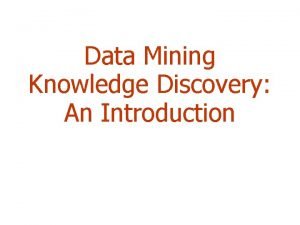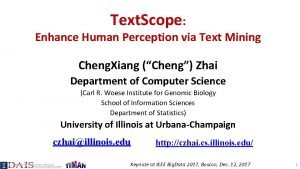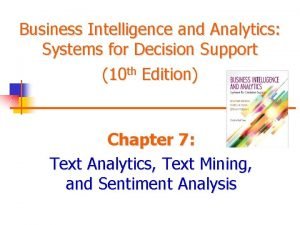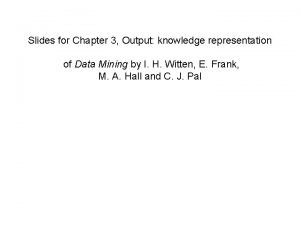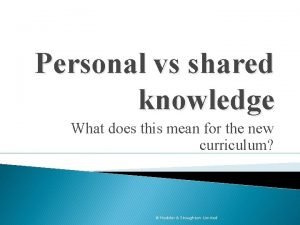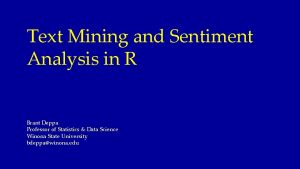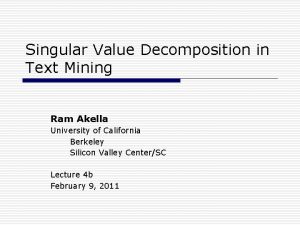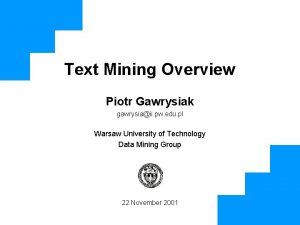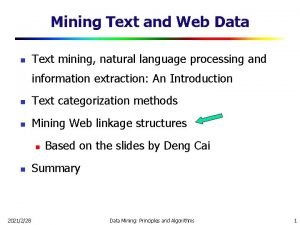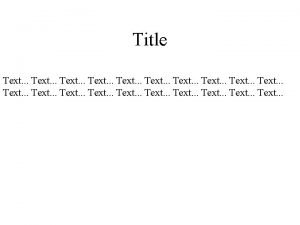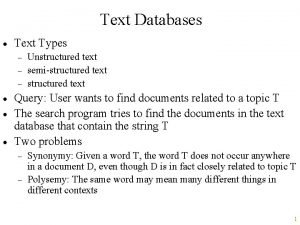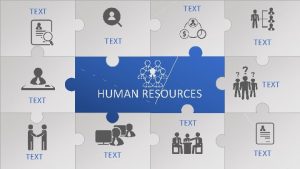Mining Text Data An Introduction Data Mining Knowledge











































- Slides: 43

Mining Text Data: An Introduction Data Mining / Knowledge Discovery Structured Data Home. Loan ( Loanee: Frank Rizzo Lender: MWF Agency: Lake View Amount: $200, 000 Term: 15 years ) 12/19/2021 Multimedia Free Text Loans($200 K, [map], . . . ) Frank Rizzo bought his home from Lake View Real Estate in 1992. He paid $200, 000 under a 15 -year loan from MW Financial. Data Mining: Principles and Algorithms Hypertext <a href>Frank Rizzo </a> Bought <a hef>this home</a> from <a href>Lake View Real Estate</a> In <b>1992</b>. <p>. . . 1

Bag-of-Tokens Approaches Documents Token Sets Four score and seven years ago our fathers brought forth on this continent, a new nation, conceived in Liberty, and dedicated to the proposition that all men are created equal. Now we are engaged in a great civil war, testing whether that nation, or … Feature Extraction nation – 5 civil - 1 war – 2 men – 2 died – 4 people – 5 Liberty – 1 God – 1 … Loses all order-specific information! Severely limits context! 12/19/2021 Data Mining: Principles and Algorithms 2

Natural Language Processing A dog is chasing a boy on the playground Det Noun Aux Noun Phrase Verb Complex Verb Semantic analysis Dog(d 1). Boy(b 1). Playground(p 1). Chasing(d 1, b 1, p 1). + Det Noun Prep Det Noun Phrase Lexical analysis (part-of-speech tagging) Prep Phrase Verb Phrase Syntactic analysis (Parsing) Verb Phrase Sentence Scared(x) if Chasing(_, x, _). Scared(b 1) Inference (Taken from Cheng. Xiang Zhai, CS 397 cxz. Data – Fall 2003) 12/19/2021 Mining: Principles and Algorithms A person saying this may be reminding another person to get the dog back… Pragmatic analysis (speech act) 3

General NLP—Too Difficult! n n Word-level ambiguity n “design” can be a noun or a verb (Ambiguous POS) n “root” has multiple meanings (Ambiguous sense) Syntactic ambiguity n “natural language processing” (Modification) n “A man saw a boy with a telescope. ” (PP Attachment) Anaphora resolution n “John persuaded Bill to buy a TV for himself. ” (himself = John or Bill? ) Presupposition n “He has quit smoking. ” implies that he smoked before. Humans rely on context to interpret (when possible). This context may extend beyond a given document! (Taken from Cheng. Xiang Zhai, CS 397 cxz. Data – Fall 2003) 12/19/2021 Mining: Principles and Algorithms 4

Shallow Linguistics Progress on Useful Sub-Goals: • English Lexicon • Part-of-Speech Tagging • Word Sense Disambiguation • Phrase Detection / Parsing 12/19/2021 Data Mining: Principles and Algorithms 5

Word. Net An extensive lexical network for the English language • Contains over 138, 838 words. • Several graphs, one for each part-of-speech. • Synsets (synonym sets), each defining a semantic sense. • Relationship information (antonym, hyponym, meronym …) • Downloadable for free (UNIX, Windows) • Expanding to other languages (Global Word. Net Association) • Funded >$3 million, mainly government (translation interest) • Founder George Miller, National Medal of Science, 1991. moist watery parched wet dry damp anhydrous arid synonym 12/19/2021 Data Mining: Principles and Algorithms antonym 6

Part-of-Speech Tagging Training data (Annotated text) This Det sentence N serves V 1 “This is a new sentence. ” as P an example Det N POS Tagger of P annotated V 2 text… N This is a new Det Aux Det Adj sentence. N Pick the most likely tag sequence. Independent assignment Most common tag Partial dependency (HMM) (Adapted from Cheng. Xiang Zhai, CS 397 cxz Fall 2003) 12/19/2021 Data–Mining: Principles and Algorithms 7

Word Sense Disambiguation ? “The difficulties of computational linguistics are rooted in ambiguity. ” N Aux V P N Supervised Learning Features: • Neighboring POS tags (N Aux V P N) • Neighboring words (linguistics are rooted in ambiguity) • Stemmed form (root) • Dictionary/Thesaurus entries of neighboring words • High co-occurrence words (plant, tree, origin, …) • Other senses of word within discourse Algorithms: • Rule-based Learning (e. g. IG guided) • Statistical Learning (i. e. Naïve Bayes) • Unsupervised Learning (i. e. Nearest Neighbor) 12/19/2021 Data Mining: Principles and Algorithms 8

Parsing Choose most likely parse tree… Grammar Lexicon V chasing Aux is N dog N boy N playground Det the Det a P on Probability of this tree=0. 000015 NP Probabilistic CFG S NP VP NP Det BNP NP NP PP BNP N VP V VP Aux V NP VP PP PP P NP S 1. 0 0. 3 0. 4 0. 3 Det BNP A N . . . V NP is chasing P NP on a boy Probability of this tree=0. 000011 S NP 0. 01 Det 0. 003 A … PP the playground 1. 0 … VP Aux dog … … VP VP BNP N Aux is dog (Adapted from Cheng. Xiang Zhai, CS 397 cxz Fall 2003) 12/19/2021 Data–Mining: Principles and Algorithms NP V chasing NP a boy PP P NP on the playground 9

Obstacles • Ambiguity “A man saw a boy with a telescope. ” • Computational Intensity Imposes a context horizon. Text Mining NLP Approach: 1. Locate promising fragments using fast IR methods (bag-of-tokens). 2. Only apply slow NLP techniques to promising fragments. 12/19/2021 Data Mining: Principles and Algorithms 10

Text Databases and IR n n Text databases (document databases) n Large collections of documents from various sources: news articles, research papers, books, digital libraries, e -mail messages, and Web pages, library database, etc. n Data stored is usually semi-structured n Traditional information retrieval techniques become inadequate for the increasingly vast amounts of text data Information retrieval n A field developed in parallel with database systems n Information is organized into (a large number of) documents n Information retrieval problem: locating relevant documents based on user input, such as keywords or example documents 12/19/2021 Data Mining: Principles and Algorithms 11

Information Retrieval n n Typical IR systems n Online library catalogs n Online document management systems Information retrieval vs. database systems n Some DB problems are not present in IR, e. g. , update, transaction management, complex objects n Some IR problems are not addressed well in DBMS, e. g. , unstructured documents, approximate search using keywords and relevance 12/19/2021 Data Mining: Principles and Algorithms 12

Basic Measures for Text Retrieval Relevant & Retrieved All Documents n n Precision: the percentage of retrieved documents that are in fact relevant to the query (i. e. , “correct” responses) Recall: the percentage of documents that are relevant to the query and were, in fact, retrieved 12/19/2021 Data Mining: Principles and Algorithms 13

Information Retrieval Techniques n n Basic Concepts n A document can be described by a set of representative keywords called index terms. n Different index terms have varying relevance when used to describe document contents. n This effect is captured through the assignment of numerical weights to each index term of a document. (e. g. : frequency, tf-idf) DBMS Analogy n Index Terms Attributes n Weights Attribute Values 12/19/2021 Data Mining: Principles and Algorithms 14

Information Retrieval Techniques n n n Index Terms (Attribute) Selection: n Stop list n Word stem n Index terms weighting methods Terms Documents Frequency Matrices Information Retrieval Models: n Boolean Model n Vector Model n Probabilistic Model 12/19/2021 Data Mining: Principles and Algorithms 15

Boolean Model n n n Consider that index terms are either present or absent in a document As a result, the index term weights are assumed to be all binaries A query is composed of index terms linked by three connectives: not, and or n n e. g. : car and repair, plane or airplane The Boolean model predicts that each document is either relevant or non-relevant based on the match of a document to the query 12/19/2021 Data Mining: Principles and Algorithms 16

Keyword-Based Retrieval n n n A document is represented by a string, which can be identified by a set of keywords Queries may use expressions of keywords n E. g. , car and repair shop, tea or coffee, DBMS but not Oracle n Queries and retrieval should consider synonyms, e. g. , repair and maintenance Major difficulties of the model n Synonymy: A keyword T does not appear anywhere in the document, even though the document is closely related to T, e. g. , data mining n Polysemy: The same keyword may mean different things in different contexts, e. g. , mining 12/19/2021 Data Mining: Principles and Algorithms 17

Similarity-Based Retrieval in Text Data n n Finds similar documents based on a set of common keywords Answer should be based on the degree of relevance based on the nearness of the keywords, relative frequency of the keywords, etc. Basic techniques Stop list n Set of words that are deemed “irrelevant”, even though they may appear frequently n E. g. , a, the, of, for, to, with, etc. n Stop lists may vary when document set varies 12/19/2021 Data Mining: Principles and Algorithms 18

Similarity-Based Retrieval in Text Data n n n 12/19/2021 Word stem n Several words are small syntactic variants of each other since they share a common word stem n E. g. , drugs, drugged A term frequency table n Each entry frequent_table(i, j) = # of occurrences of the word ti in document di n Usually, the ratio instead of the absolute number of occurrences is used Similarity metrics: measure the closeness of a document to a query (a set of keywords) n Relative term occurrences n Cosine distance: Data Mining: Principles and Algorithms 19

Vector Space Model n n Documents and user queries are represented as m-dimensional vectors, where m is the total number of index terms in the document collection. The degree of similarity of the document d with regard to the query q is calculated as the correlation between the vectors that represent them, using measures such as the Euclidian distance or the cosine of the angle between these two vectors. 12/19/2021 Data Mining: Principles and Algorithms 20

Latent Semantic Indexing n n Basic idea n Similar documents have similar word frequencies n Difficulty: the size of the term frequency matrix is very large n Use a singular value decomposition (SVD) techniques to reduce the size of frequency table n Retain the K most significant rows of the frequency table Method n Create a term x document weighted frequency matrix A n SVD construction: A = U * S * V’ n Define K and obtain Uk , , Sk , and Vk. n Create query vector q’. n Project q’ into the term-document space: Dq = q’ * Uk * Sk-1 n Calculate similarities: cos α = Dq. D / ||Dq|| * ||D|| 12/19/2021 Data Mining: Principles and Algorithms 21

Probabilistic Model n n Basic assumption: Given a user query, there is a set of documents which contains exactly the relevant documents and no other (ideal answer set) Querying process as a process of specifying the properties of an ideal answer set. Since these properties are not known at query time, an initial guess is made This initial guess allows the generation of a preliminary probabilistic description of the ideal answer set which is used to retrieve the first set of documents An interaction with the user is then initiated with the purpose of improving the probabilistic description of the answer set 12/19/2021 Data Mining: Principles and Algorithms 22

Types of Text Data Mining n n n n Keyword-based association analysis Automatic document classification Similarity detection n Cluster documents by a common author n Cluster documents containing information from a common source Link analysis: unusual correlation between entities Sequence analysis: predicting a recurring event Anomaly detection: find information that violates usual patterns Hypertext analysis n Patterns in anchors/links n Anchor text correlations with linked objects 12/19/2021 Data Mining: Principles and Algorithms 23

Keyword-Based Association Analysis n Motivation n n Collect sets of keywords or terms that occur frequently together and then find the association or correlationships among them Association Analysis Process n n Preprocess the text data by parsing, stemming, removing stop words, etc. Evoke association mining algorithms n n n View a set of keywords in the document as a set of items in the transaction Term level association mining n n 12/19/2021 Consider each document as a transaction No need for human effort in tagging documents The number of meaningless results and the execution time is greatly reduced Data Mining: Principles and Algorithms 24

Text Classification n Motivation n Automatic classification for the large number of on-line text documents (Web pages, e-mails, corporate intranets, etc. ) Classification Process n Data preprocessing n Definition of training set and test sets n Creation of the classification model using the selected classification algorithm n Classification model validation n Classification of new/unknown text documents Text document classification differs from the classification of relational data n Document databases are not structured according to attributevalue pairs 12/19/2021 Data Mining: Principles and Algorithms 25

Text Classification(2) n Classification Algorithms: n Support Vector Machines n K-Nearest Neighbors n Naïve Bayes n Neural Networks n Decision Trees n Association rule-based n Boosting 12/19/2021 Data Mining: Principles and Algorithms 26

Document Clustering n n Motivation n Automatically group related documents based on their contents n No predetermined training sets or taxonomies n Generate a taxonomy at runtime Clustering Process n Data preprocessing: remove stop words, stem, feature extraction, lexical analysis, etc. n Hierarchical clustering: compute similarities applying clustering algorithms. n Model-Based clustering (Neural Network Approach): clusters are represented by “exemplars”. (e. g. : SOM) 12/19/2021 Data Mining: Principles and Algorithms 27

Text Categorization n Pre-given categories and labeled document examples (Categories may form hierarchy) Classify new documents A standard classification (supervised learning ) problem Sports Categorization System Business Education Sports Business … … Science Education 12/19/2021 Data Mining: Principles and Algorithms 28

Applications n n n News article classification Automatic email filtering Webpage classification Word sense disambiguation …… 12/19/2021 Data Mining: Principles and Algorithms 29

Categorization Methods n n Manual: Typically rule-based n Does not scale up (labor-intensive, rule inconsistency) n May be appropriate for special data on a particular domain Automatic: Typically exploiting machine learning techniques n Vector space model based n n n Probabilistic or generative model based n 12/19/2021 Prototype-based (Rocchio) K-nearest neighbor (KNN) Decision-tree (learn rules) Neural Networks (learn non-linear classifier) Support Vector Machines (SVM) Naïve Bayes classifier Data Mining: Principles and Algorithms 30

Vector Space Model n n Represent a doc by a term vector n Term: basic concept, e. g. , word or phrase n Each term defines one dimension n N terms define a N-dimensional space n Element of vector corresponds to term weight n E. g. , d = (x 1, …, x. N), xi is “importance” of term i New document is assigned to the most likely category based on vector similarity. 12/19/2021 Data Mining: Principles and Algorithms 31

VS Model: Illustration Starbucks C 2 Category 3 C 3 new doc Microsoft 12/19/2021 Java C 1 Category 1 Data Mining: Principles and Algorithms 32

How to Assign Weights n Two-fold heuristics based on frequency n TF (Term frequency) n n n IDF (Inverse document frequency) n n 12/19/2021 More frequent within a document more relevant to semantics e. g. , “query” vs. “commercial” Less frequent among documents more discriminative e. g. “algebra” vs. “science” Data Mining: Principles and Algorithms 33

TF Weighting n Weighting: n More frequent => more relevant to topic n n n e. g. “query” vs. “commercial” Raw TF= f(t, d): how many times term t appears in doc d Normalization: n Document length varies => relative frequency preferred n 12/19/2021 e. g. , Maximum frequency normalization Data Mining: Principles and Algorithms 34

IDF Weighting n n Ideas: n Less frequent among documents more discriminative Formula: n — total number of docs k — # docs with term t appearing (the DF document frequency) 12/19/2021 Data Mining: Principles and Algorithms 35

TF-IDF Weighting n n n TF-IDF weighting : weight(t, d) = TF(t, d) * IDF(t) n Freqent within doc high tf high weight n Selective among docs high idf high weight Recall VS model n Each selected term represents one dimension n Each doc is represented by a feature vector n Its t-term coordinate of document d is the TF-IDF weight n This is more reasonable Just for illustration … n Many complex and more effective weighting variants exist in practice 12/19/2021 Data Mining: Principles and Algorithms 36

How to Measure Similarity? n n Given two document Similarity definition n dot product n 12/19/2021 normalized dot product (or cosine) Data Mining: Principles and Algorithms 37

Illustrative Example text mining search engine text doc 1 travel text doc 2 Sim(newdoc, doc 1)=4. 8*2. 4+4. 5*4. 5 Sim(newdoc, doc 2)=2. 4*2. 4 Sim(newdoc, doc 3)=0 map travel text IDF(faked) 2. 4 doc 3 To whom is newdoc more similar? government president congress …… 12/19/2021 mining 4. 5 doc 1 doc 2 doc 3 2(4. 8) 1(4. 5) 1(2. 4 ) newdoc 1(2. 4) travel 2. 8 map search engine govern president congress 3. 3 2. 1 5. 4 2. 2 3. 2 4. 3 1(2. 1) 1(5. 4) 2 (5. 6) 1(3. 3) 1 (2. 2) 1(3. 2) 1(4. 3) 1(4. 5) Data Mining: Principles and Algorithms 38

VS Model-Based Classifiers n What do we have so far? n A feature space with similarity measure n This is a classic supervised learning problem n n Search for an approximation to classification hyper plane VS model based classifiers n K-NN n Decision tree based n Neural networks n Support vector machine 12/19/2021 Data Mining: Principles and Algorithms 39

Categorization Methods n n Vector space model n K-NN n Decision tree n Neural network n Support vector machine Probabilistic model n n Naïve Bayes classifier Many, many others and variants exist [F. S. 02] n 12/19/2021 e. g. Bim, Nb, Ind, Swap-1, LLSF, Widrow-Hoff, Rocchio, Gis-W, … … Data Mining: Principles and Algorithms 40

Evaluations n Effectiveness measure n Classic: Precision & Recall 12/19/2021 n Precision n Recall Data Mining: Principles and Algorithms 41

Evaluation (con’t) n Benchmarks n Classic: Reuters collection n n A set of newswire stories classified under categories related to economics. Effectiveness n n n 12/19/2021 Difficulties of strict comparison n different parameter setting n different “split” (or selection) between training and testing n various optimizations … … However widely recognizable n Best: Boosting-based committee classifier & SVM n Worst: Naïve Bayes classifier Need to consider other factors, especially efficiency Data Mining: Principles and Algorithms 42

Summary: Text Categorization n Wide application domain n Comparable effectiveness to professionals n Manual TC is not 100% and unlikely to improve substantially. n n A. T. C. is growing at a steady pace Prospects and extensions n Very noisy text, such as text from O. C. R. n Speech transcripts 12/19/2021 Data Mining: Principles and Algorithms 43
 Introduction to data mining and knowledge discovery
Introduction to data mining and knowledge discovery Making connections
Making connections Mining complex types of data in data mining
Mining complex types of data in data mining Web text mining
Web text mining Introduction to data warehousing and data mining
Introduction to data warehousing and data mining Text analytics and text mining
Text analytics and text mining Text analytics and text mining
Text analytics and text mining Mining multimedia databases
Mining multimedia databases Knowledge representation in data mining
Knowledge representation in data mining Cs 412 introduction to data mining
Cs 412 introduction to data mining Azure data mining
Azure data mining Strip mining vs open pit mining
Strip mining vs open pit mining Strip mining vs open pit mining
Strip mining vs open pit mining Difference between strip mining and open pit mining
Difference between strip mining and open pit mining What is shared knowledge
What is shared knowledge Knowledge shared is knowledge squared
Knowledge shared is knowledge squared Knowledge shared is knowledge multiplied
Knowledge shared is knowledge multiplied Knowledge creation and knowledge architecture
Knowledge creation and knowledge architecture Contoh shallow knowledge dan deep knowledge
Contoh shallow knowledge dan deep knowledge What is a priori and a posteriori knowledge
What is a priori and a posteriori knowledge Book smarts vs street smarts
Book smarts vs street smarts Knowledge claim
Knowledge claim Gertler econ
Gertler econ Data reduction in data mining
Data reduction in data mining What is data mining and data warehousing
What is data mining and data warehousing What is missing data in data mining
What is missing data in data mining Concept hierarchy generation for nominal data
Concept hierarchy generation for nominal data Data reduction in data mining
Data reduction in data mining Data reduction in data mining
Data reduction in data mining Data cube technology in data mining
Data cube technology in data mining Data reduction in data mining
Data reduction in data mining Arsitektur data mining
Arsitektur data mining Perbedaan data warehouse dan data mining
Perbedaan data warehouse dan data mining Olap crm
Olap crm Multidimensional analysis and descriptive mining of complex
Multidimensional analysis and descriptive mining of complex Data warehouse and olap technology for data mining
Data warehouse and olap technology for data mining Noisy data in data mining
Noisy data in data mining What are the three layers of data warehouse architecture
What are the three layers of data warehouse architecture Markku roiha
Markku roiha Data compression in data mining
Data compression in data mining Data warehouse dan data mining
Data warehouse dan data mining Text mining and sentiment analysis in r
Text mining and sentiment analysis in r Svd text mining
Svd text mining Piotr gawrysiak
Piotr gawrysiak
